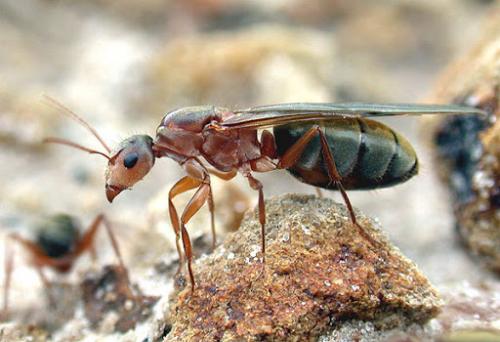Ants in the earthquake forecast?

The geologist Ulrich Schreiber has found out that wood ants build their mounds on crevices that are under tension. Earthquakes occur in such places. Now he's investigating whether the insects might foresee the quake.
By Kerstin Helmerdig There are research approaches that sound so absurd that it is precise because of this that one becomes particularly curious. It is exactly the same as the idea of Ulrich Schreiber, Professor of Geology at the University of Duisburg-Essen.
Thematically, he has embarked on shaky terrain and studies earthquakes. He assumes that there are animals that can recognize the first signals of a quake and react accordingly. Such an early warning system could emerge in the long term. "There are many living things that are more sensory than humans," explains Schreiber.
He and his colleagues at the Faculty of Biology have chosen the wood ant as a test subject. "We assume that the wood ant of the genus Formica sense the earliest signs of earthquakes - and react to them," he explains. The reason: These ants build their nests on cracks in the earth from which gases escape - typical for earthquake areas.
Since the ants have adapted to the concentration of the escaping gas in their nest, they notice when this concentration changes. That happens just before an earthquake. Then, little by little, the tension in the ground is discharged and small cracks appear - more and more gas escapes. These harbingers of a quake cannot be measured by humans.
Ants, on the other hand, are sensitive enough to notice fluctuations in the gas composition, says Schreiber. Shortly before an earthquake, concentrations that are quite toxic for the animals are released. "It is likely that the ants change their behavior when the concentration of the gases increases," said Schreiber.
To prove this, the team installed two cameras in the Eifel, where previous studies were located, which record a hill of forest ants and one of the meadow ants via infrared day and night. For two and a half years. The images show how ants behave and how active they are. There are different phases in their day-night rhythm. In the morning they crawl around more, at noon they tend to rest before it gets more active in the anthill in the late afternoon. They stay calm at night.
The recordings must now be evaluated. "That is an incredible amount of data," says Schreiber. The team has brought on board a physicist who specializes in automatic data processing for support. Nevertheless, it will take months before the result is available. "We hope to be able to show that the ants change their usual rhythm before an earthquake," explains Schreiber.
Earlier there were initial indications of this
thesis: "What exactly they do then is unclear," says Schreiber. But
with the data analysis, the geologists and biologists at least want to show
that the ants are reacting specifically to the danger of earthquakes.Read more about ant in hindi
To do this, however, other influences such as the weather, the tides, and the phases of the moon must first be calculated. "The ants are suitable for this research because they stay true to their location," explains Schreiber. As early as 2010, Gabriele Berberich, a member of his workgroup, was able to show that wood ants often build their nests on so-called fault zones.
At these points, there are fractures in the earth's crust from which gases escape. The special gas composition at the breakpoints in earthquake areas is vital for the insects: In order to raise the brood, a certain oxygen concentration must be present. The little ants need less oxygen than is normally available in the air.
This is why the insects store the carbon dioxide that escapes from the earth at breakpoints in the nest, and so they receive the right dose for the brood. Based on this knowledge that ants live near the tectonic plates, Schreiber and his colleagues came up with the idea of the current experiment.
If it works, the researchers would have discovered a possible early warning system. "In the end, it should show a clear change in the ants' behavior before the quake," says Schreiber. Perhaps all anthills in the world will then be equipped with a webcam.
Comments